Peace and security in the Euro-Atlantic region are threatened by growing instability on the southern and eastern flanks of NATO. It is Russia’s military posture and provocative military activities that have put deterrence and collective defence again high on the Alliance’s agenda. Since the Russian annexation of the Crimea in 2014 NATO has started to adapt to ensure that its deterrence and defence posture remains credible, coherent and resilient. Military exercises have been stepped up and enhanced air policing has been initiated in the Baltic and Black Sea regions. Cyber defence, and defence against missile attacks have been strengthened, while the trend of declining defence budgets has been reversed.
Lieutenant General Jan Broeks*
As of 2014 the Euro-Atlantic security environment has become less stable and predictable as a result of a series of actions taken by Russia: Russia’s illegal and illegitimate annexation of Crimea and ongoing destabilization of eastern Ukraine; Russia’s military posture and provocative military activities, such as the deployment of modern dual-capable missiles in Kaliningrad, repeated violation of NATO Allied airspace, and the continued military build-up in the Crimea; its significant investments in the modernization of its strategic forces; its irresponsible and aggressive nuclear rhetoric; its large-scale, no-notice snap exercises; and the growing number of its exercises with a nuclear dimension.
In parallel, growing instability in the Mediterranean region, from the Middle East to North Africa, as well as transnational and multi-dimensional threats, are challenging our security. These factors can all have long-term consequences for peace and security in the Euro-Atlantic region and for stability across the globe. Yet it is mainly Russian military actions that have put deterrence and collective defence again high on NATO’s agenda.
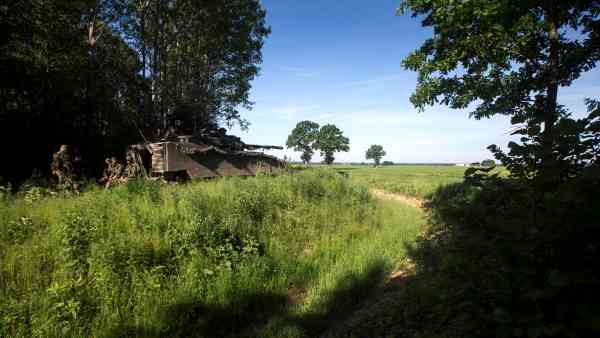
enhanced Forward Presence, Lithuania: demonstrating solidarity, determination, and ability to act by triggering an immediate Allied response to any aggression. Photo MCD, Gerben van Es
Alliance adaptation in perspective
As a consequence of this new environment, the Alliance has started to adapt to ensure that its deterrence and defence posture remains credible, coherent and resilient. Military adaptation is only one of the three distinct lines of effort driving the long-term adaptation of the Alliance, together with political and institutional adjustment. The objective is the development of an Alliance adaptable by design, where the capacity to anticipate and react to change is integral to how it operates. Since 2014, reforms have contributed to improved effectiveness and efficiency, moving NATO towards greater readiness and responsiveness.
The three core tasks – collective defence, crisis management and cooperative security – remain extant, as per the 2010 Strategic Concept.[1] However, there has been an adaptation and re-balancing of the weight of effort and activities related to these core tasks to reflect the current security environment and accommodate the interests and views of all 29 member states.
To place the adaptation of NATO’s Military Instrument of Power into perspective, one has to go back in history. Back in 1990, the NATO London Summit provided a sense of the positive trends in the security environment. The Summit Declaration stated that ‘Europe has entered a new, promising era [...] As Soviet troops leave Eastern Europe and a treaty limiting conventional armed forces is implemented, the Alliance’s integrated force structure and its strategy will change fundamentally.’[2] It then noted that NATO will ‘field smaller forces,’ and ‘scale back the readiness of its active units, reducing training requirements and the number of exercises.’ Also, if and when needed, NATO would ‘more heavily rely on the ability to build up larger forces.’[3] Accordingly, the Alliance will have to rely on adequate infrastructure to allow for reinforcement if necessary.
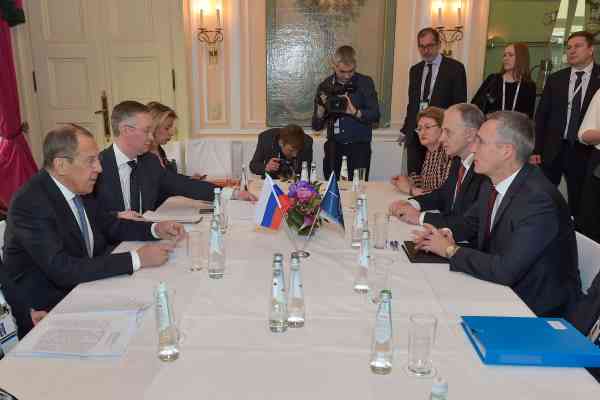
At the Munich Security Conference in February 2020, NATO Secretary General Jens Stoltenberg (right) and Russian Foreign Minister Sergey Lavrov (opposite) discuss security matters. Photo NATO
Two decades later, these decisions were followed by the 2010 Lisbon Summit Declaration, in which the Allies state that they ‘want to see a true strategic partnership between NATO and Russia, and we will act accordingly, with the expectation of reciprocity from Russia.’[4] This language was then replicated in the 2010 New Strategic Concept. At the time, the absence of an existential threat allowed NATO to adapt to a changing world and new challenges. From the 1990s to early 2014, NATO’s Military Instrument of Power was predominantly used for operations of choice including missions and operations abroad, such as crisis management. Coalitions were established to conduct operations and sovereign nations could decide on a case-by-case basis whether or not to participate. Such operations were not subject to any particular urgency, therefore nations followed their own decision-making procedures and force-generated contributions at their own pace.
Aim
The aim of this article is to describe the gradual but deliberate transformation that guided the adaptation of NATO’s Military Instrument of Power. This transformation was necessary in order to adapt to the changed and more complex security situation whilst preserving the Alliance’s Centre of Gravity, i.e. solidarity through cohesive action.
Military adaptation
As of 2014, the Alliance has implemented the largest reinforcement of its deterrence and defence posturing since the end of the Cold War. The Alliance tripled the size of the NATO Response Force to 40,000 troops, and created a ‘spearhead force’ within it, known as the Very High Readiness Joint Task Force (VJTF),[5] ready to move within days. Military exercises have been stepped up and enhanced air policing has been initiated in the Baltic and Black Sea regions. Cyber defence, and defence against missile attacks have also been strengthened.
The Alliance has also reversed the trend of declining defence budgets, in the light of growing needs for investment in capabilities and to further a more balanced burden sharing. A more robust deterrence and defence posture strengthens the Alliance’s cohesion, including the trans-atlantic link, through an equitable and sustainable distribution of roles and responsibilities. NATO must also continue to adapt its strategy in line with security trends to ensure that its overall deterrence and defence posture is capable of addressing potential adversaries’ doctrine and capabilities.
To respond to the changes in the security environment on NATO’s borders and further afield, the Readiness Action Plan (RAP) was approved at the 2014 Wales Summit.[6] It provides a comprehensive package of measures addressing both the continuing need for assurance of Allies and the adaptation of the Alliance’s military strategic posture.
Measures adopted deal with:
- an Enhanced NATO Response Force (eNRF);
- the establishment of a Very High Readiness Joint Task Force (VJTF);
- the establishment of eight multinational NATO Force Integration Units (NFIUs) on the territory of Allies in the eastern part of the Alliance;
- as part of the NATO Force Structure, making the Headquarters of a Multinational Corps Northeast in Poland fully operational, and establishing the Headquarters of a Multinational Division Southeast in Romania to take command of the NATO Force Integration Units and to provide flexible command and control options in their regions;
- the enhancement of NATO Standing Naval Forces with additional capabilities;
- delivering a more ambitious NATO exercise programme;
- enhancing advance planning and enabling accelerated decision-making to ensure both military and political responsiveness;
- a strategy on NATO’s role in Countering Hybrid Warfare, implemented in coordination with the EU;
- the establishment of a framework for NATO’s adaptation in response to growing challenges and threats from the south (Framework for the South).
The assurance measures include continuous air, land, and maritime presence and meaningful military activity in the eastern part of the Alliance, both on a rotational basis. They provide the fundamental baseline requirement for assurance and deterrence, and are flexible and scalable to respond to the evolving security situation. In addition, tailored assurance measures for Turkey reflects the growing security challenges from the south and contribute to the security of the Alliance as a whole.
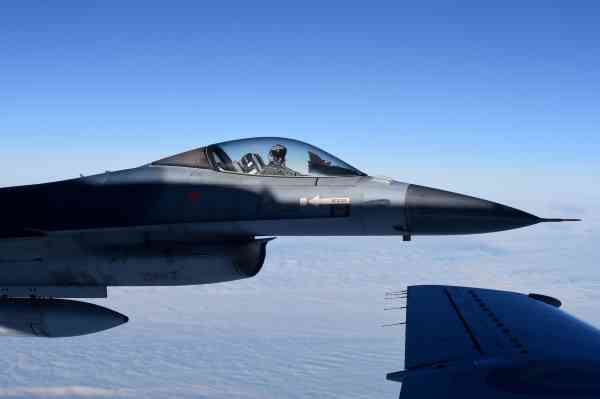
A Royal Netherlands Air Force F-16 fighter jet over Estonia: NATO’s Joint Air Power Strategy is a key enabler for peacetime air policing missions. Photo NATO
Building on the Readiness Action Plan, at the 2016 Warsaw Summit, the Alliance adopted a broad approach to deterrence and defence, drawing upon all of the tools at NATO’s disposal. One of the key decisions was the establishment of the enhanced Forward Presence (eFP) in Estonia, Latvia, Lithuania and Poland aimed at demonstrating, as part of the overall posture, Allies’ solidarity, determination, and ability to act by triggering an immediate Allied response to any aggression.
In parallel, the development of a tailored Forward Presence (tFP) in the southeast region of the Alliance included appropriate measures, tailored to the Black Sea region. This reflected the Romanian initiative to establish a multinational framework brigade to help improve integrated training of Allied units under Headquarters Multinational Division Southeast. A number of air and maritime measures have been undertaken in the Black Sea region to enhance NATO’s presence and maritime activity.
Then, at the 2018 Brussels Summit, with the RAP and related measures as the strategic background, members launched a NATO Readiness Initiative (NRI)[7] to ensure that more high-quality, combat-capable national forces at high readiness can be made available to NATO. From within the overall pool of forces, NATO members will offer an additional 30 major naval combatants, 30 heavy or medium maneuver battalions, and 30 kinetic air squadrons, with enabling forces, at 30 days’ readiness or less. The NRI will further enhance the Alliance’s rapid response capability, either for reinforcement of Allies in support of deterrence or collective defence, including for high-intensity warfighting, or for rapid military crisis intervention, if required. These measures will also promote the importance of effective combined arms and joint operations.
Towards Responsiveness, Readiness and Reinforcement
Since the Warsaw Summit in 2016, a number of steps have been taken to support the deployment and sustainment of Allied forces and their equipment into, from, and within the entire Alliance territory. To that end, the implementation of the Enablement Plan for SACEUR’s Area of Responsibility (AOR) received the highest priority.[8] Responsiveness, Readiness and Reinforcement are the strategic imperatives for the work on the implementation of the Alliance’s strengthened Deterrence and Defence Posture. Responsiveness encompasses two separate elements. The first element requires a military posture that includes having the right forces at the right place and at the right time to be able to respond in a timely, appropriate and credible manner to assure, deter and address contingencies that might arise. The second element of responsiveness is expeditious political decision-making. Readiness is about having the right capabilities and forces that are trained, interoperable, deployable and maintained in the right operational structures and groupings and at an appropriate notice to move to meet all Alliance requirements. The ability to provide rapid and timely reinforcement of a threatened member state is essential for the credibility of the Alliance’s Deterrence and Defence Posture, underpinning the tripwire function of the Forward Presences and ensuring effective reinforcement in other regions, if required. Equally essential is the enablement of SACEUR’s AOR required for NATO to be able to rapidly move forces into, within and from the AOR in all directions and to sustain them.
In this context, the adaptation and strengthening of the NATO Command Structure (NCS),[9] the military backbone of the Alliance, enables the Supreme Commanders to command and control forces to deal with any military challenge or security threat at any time, from any direction, including large-scale operations for collective defence. It also ensures adequate transformation and preparation for the future, in particular through capability development, education, and training. It includes the establishment of:
- A Cyberspace Operations Centre at SHAPE in Belgium to provide situational awareness and coordination of NATO operational activity within cyberspace;
- A Joint Force Command Norfolk headquarters in the United States to focus on protecting the transatlantic lines of communication;
- A Joint Support and Enabling Command in Germany to ensure freedom of operation and sustainment in the rear area in support of the rapid movement of troops and equipment into, across, and from Europe.
The adapted NCS enhances and strengthens the relationship with the NATO Force Structure headquarters and national headquarters, which also improves the Alliance’s regional understanding.
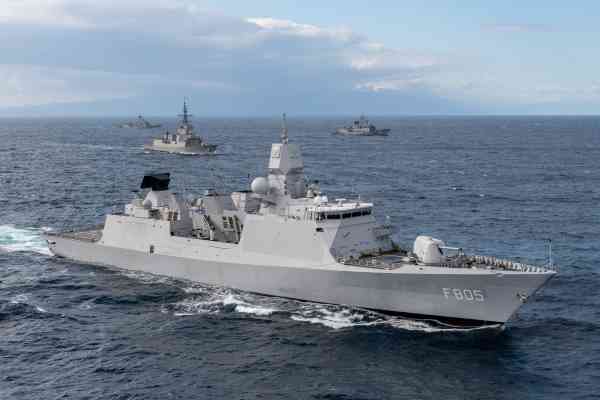
The strengthening of NATO’s maritime capabilities responded to the need of adapting to a complex and increasingly unpredictable maritime security environment. Photo MARCOM, Christian Valverde
Domains of operations: conventional and asymmetric threats
The adaptation of the Alliance over the recent years was aimed at making it fit-for-purpose in the new strategic environment. NATO’s adaptation since the Wales Summit in 2014 has been, and continues to be, a process of critical strategic thinking, which allows the Alliance to meet current and emerging security challenges ahead. The world – and NATO’s adversaries – have moved on and NATO must undertake a process of continuous adaptation to ensure that it can face the broad spectrum of threats and challenges.
The strengthening of the Alliance’s maritime capabilities responded to the need of adapting to a complex, more crowded, rapidly evolving, and increasingly unpredictable maritime security environment. Consequently, NATO continued to intensify and expand the implementation of the Alliance Maritime Strategy, further enhancing the Alliance’s effectiveness in the maritime domain, and reinvigorating NATO’s Standing Naval Forces. The Standing Naval Forces are a core maritime capability of the Alliance and are the centerpiece of NATO’s maritime posture. They have been enhanced and aligned with NATO’s eNRF to provide NATO’s highest readiness maritime forces. The Alliance is reinforcing its maritime posture and concrete steps have been taken to improve the overall maritime situational awareness. Similarly, in the air domain, Allies have agreed at the 2018 Brussels Summit a Joint Air Power Strategy, a key enabler for NATO’s peacetime Air Policing and Ballistic Missile Defence missions.
Furthermore, NATO joined the Global Coalition to Defeat ISIS, and has enhanced its AWACS and air-to-air refueling support. NATO’s Military Concept for Counter-Terrorism established that NATO will contribute more effectively to the prevention of terrorism and increase resilience to acts of terrorism. To this end, the Alliance will coordinate and consolidate its counter-terrorism efforts and focus on three main areas: awareness, capabilities and engagement. Most notably, the recognition of cyberspace as a domain of operations represented a milestone in the Alliance’s resolve against emerging threats. Through the Cyber Defence Pledge, NATO committed to enhance the cyber defence of national networks and infrastructures. NATO will continue to adapt to the evolving cyber threat landscape, which is affected by both state and non-state actors, including state-sponsored ones.
NATO New Military Strategy
Since the Wales Summit, there has been a change in the Alliance’s paradigm, shifting from a reactive to a proactive approach, culminating with the May 2019 Chiefs of Defence approval of the new NATO Military Strategy (NMS),[10] a capstone document which supports the ongoing wider military adaptation and modernization of the Alliance. The 2010 Strategic Concept, coupled with the outputs from the Wales, Warsaw and Brussels Summits, as well as the actions taken to follow through on Alliance assurance and adaptation measures, have all formed the basis for NMS. It constitutes the basis for further adaptation of the Alliance’s Military Instrument of Power. The approval of NMS marked a fundamental step forward in adapting the Alliance for the increasingly complex security challenges. Under the broader umbrella of NATO’s policy on Deterrence and Defence, Projecting Stability, and the Fight against Terrorism, the NMS supports the Alliance’s three core tasks and the overarching Alliance messaging. It outlines how the Alliance deters and defends and how it provides military support to the efforts in Projecting Stability and the Fight Against Terrorism in a coherent manner.
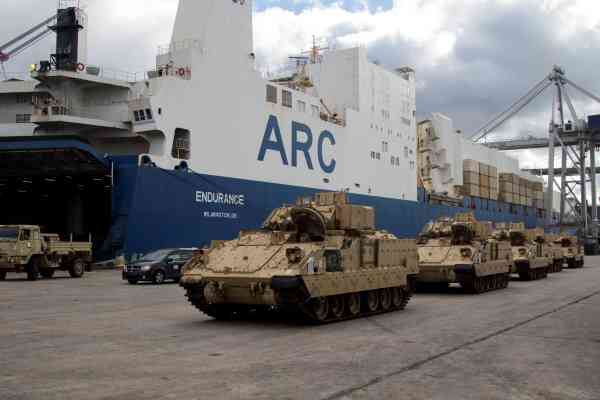
U.S. Army M2 Bradley fighting vehicles are heading out for exercise DEFENDER Europe 20: NATO’s strategic adaption over the short course of five years has been impressive. Photo US Army, Carlos Cuebas Fantauzzi
Evaluation
Following the fundamental and substantial changes in the ever more complex security situation NATO has adapted almost instantaneously. This adaptation – as the changes took the Allies ‘more-or-less’ by surprise – was not guided and implemented by a diligently developed ‘grand design’ but more gradually and deliberately over some years. This gradual and deliberate path had two important principles at its foundation, the first of which was political guidance based upon solid military advice and the second, maintaining solidarity amongst Allies and coherence during the adaptation. The required political guidance was developed on the journey from the Wales Summit [2014] through Warsaw [2016] and Brussels [2017 and 2018]. Solid military advice was built upon SACEUR’s and SACT’s advice together with that of all the Allies. Achieving consensus on the military advice was not always easy as perceptions amongst Allies differed, as they were mainly driven by a sense of urgency. More to the east of the Treaty territory the Russian threat was seen as most urgent, whilst at the southern border of the Alliance urgency was driven by migrant flows and the terrorist threat.
Building consensual military advice required a profound mutual understanding of the different problem-sets by all Allies; so briefings, consultations, text proposals but most of all flexibility for the sake of consensus. This required direct involvement and buy-in by the Chiefs-of-Defence themselves.
NATO’s International Military Staff played an important role in this process by acting as a go-between for nations and both Strategic Commands (SHAPE and ACT); in doing so they reflected the different problem sets with the accompanying perceptions in the preparatory work for the Military Committee decision making and identified alternative (parts of) solutions or different text-proposals. Secondly, the briefings by SHAPE and the International Military Staffs informed the North Atlantic Council, thereby raising the level of political understanding required to build bridges between nations but also from the military domain to the political domain.
Solidarity and coherence have been maintained and sustained by building the adaptation through direct evolutionary implementation, i.e. by taking smaller steps instead of following a robust revolutionary approach. This allowed for keeping Allies on board; it allowed for nations to redirect and adapt national armed forces in order to contribute better to the adaptation of NATO’s Military Instrument of Power and, finally, it allowed for careful consideration of the impact on the two other adaptation efforts, namely political and institutional.
Conclusion
The last 25 years of continuous reductions in financial resourcing and readiness levels have left NATO and its partners inadequately prepared for the emerging new security environment. This is not to question the changed focus and reduced resourcing and readiness levels throughout 1990 up onto and including 2010. On the contrary, these were all the results of deliberate decisions based upon valid assessments of the changing security. Although one might argue that the Alliance and its member states have missed some signals since 2008; we were looking for the indicators we wanted to see instead of what we needed to see.
Nevertheless, NATO’s adaptation since the Russian annexation of the Crimea in 2014 is something to be proud of and a testimony to the Alliance’s agility and solidarity. Taking deliberate consensus-based decisions and carefully coordinating political will and military capabilities could take the Alliance even further. It is impressive to have witnessed NATO’s strategic adaption over the short course of five years. Moreover, NATO’s Military Strategy provides – from a military perspective – contextualization while also allowing for purpose and a coherent approach for now and the immediate future.
* The author was Director General of NATO’s International Military Staff from mid 2016 until mid 2019. Since September 2019 he has retired from active service and now supports NATO in his capacity of Senior Mentor.
[1] Active Engagement, Modern Defence. Strategic Concept for the Defence and Security of the Members of the North Atlantic Treaty Organization (Lisbon, NATO Summit, 19-20 November 2010) pp. 7 and 8; para 4a-4c.
[2] Declaration on a Transformed North Atlantic Alliance (London, NATO Summit, 5-6 July 1990) para 1.
[3] Idem, para. 14.
[4] Lisbon Summit Declaration (Lisbon, NATO Summit, 20 November 2010) para 23.
[5] Wales Summit Declaration (Newport, NATO Summit, 5 September 2014) para 8.
[6] Idem, para 5.
[7] Brussels Summit Declaration (Brussels, NATO Summit, 11-12 July 2018) para 14.
[8] Idem, para 16.
[9] Idem, para 29.
[10] ‘NATO Chiefs of Defence discuss future Alliance adaptation’ (Brussels, NATO, 22 May 2019). See: https://www.nato.int/cps/en/natohq/news_166244.htm .